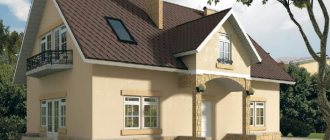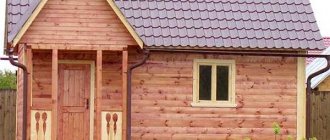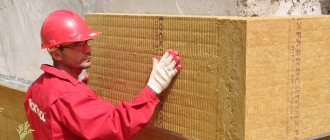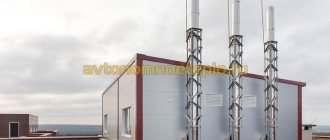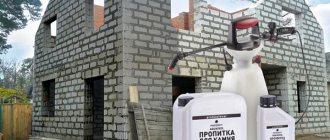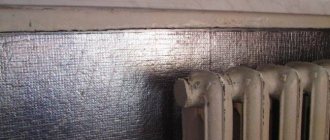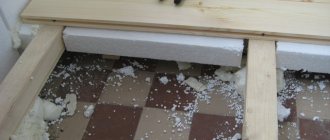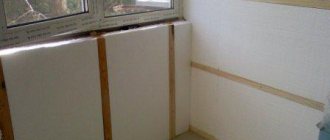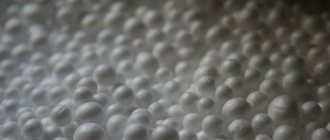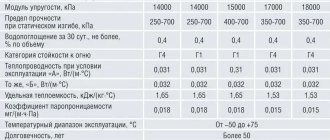No. 1. Insulation of an apartment building: outside or inside?
The walls of the house can be insulated from the inside and outside . We all know that external insulation is used much more often, because it is considered more effective. However, in some cases, only internal thermal insulation is applicable, and, by the way, it also has its advantages.
Internal insulation can solve the problem of energy saving, but the process must be approached very carefully. An error in calculations or installation can cause the dew point to shift inside the house, which will cause the façade wall and insulation to become wet. The consequences of this process are dampness and mold in the apartment, a decrease in the durability of the external walls of the house and, naturally, a decrease in the thermal insulation qualities of the insulation. Other disadvantages of internal insulation include :
- reducing the usable area of the room;
- the need to install a powerful ventilation system;
- the difficulty of carrying out work to avoid moisture condensation;
- it will be impossible to live in the room during insulation work;
- even if all work is carried out correctly, it will not be possible to avoid freezing of the wall of the house, because it will not warm up from internal heat;
- faster cooling of walls.
Internal insulation of an apartment in an apartment building has its advantages :
- faster heating of walls;
- the ability to complete all the work independently, since there is no need to involve teams with industrial climbers. On the other hand, in order to competently complete all the work, a high level of qualification will be required;
- internal insulation can be performed together with repair work;
- internal insulation is the only way to make an apartment warmer if it is located in a building that has historical value and residents are prohibited from changing the appearance of the facade.
External insulation of the facade of an apartment building has many more advantages:
- the heat inside is retained longer, the room maintains a relatively stable temperature in both summer and winter;
- the area of the apartment does not decrease;
- You don’t have to leave the apartment during insulation work;
- a layer of insulation and decorative finishing protect the walls of the house, extending their service life.
Among the disadvantages :
- impossibility of carrying out external insulation on your own. True, some residents of the first floors take on such work, but at the same time you need to be well confident in your own qualifications;
- spot external insulation is more harmful than beneficial, which we will discuss below.
External insulation can change the appearance of the facade of a house, and this can be both a plus and a minus. If the entire house is insulated at once, then from a typical gray Soviet high-rise building you can end up with a nice modern house with a stylish facade. This is a significant plus. But if the residents have not reached a consensus on issues of insulation, then insulation is carried out fragmentarily, in patches, and then the appearance of such a house leaves much to be desired.
No. 2. Is a permit required for insulation?
In Russia there is no unified document on the insulation of facades of apartment buildings; slightly different rules apply in different cities and regions. In some regions of the country there are state programs for insulating high-rise buildings, and all work is carried out using budget funds. If your home is not one of the lucky ones, then before performing insulation you will have to contact the utility services.
The external walls of a house are common property , even if the apartment is privately owned. Since insulating the facade will change the appearance of the house, coordination with utility services and local architects will be required. As a rule, there are no problems. You just need to go to the appropriate management authority and write a petition, and the chances of getting a positive response increase if the petition is written simultaneously by several residents who want to insulate their apartments. In addition, joint integral insulation of the facade is many times more effective and better than “patchwork” thermal insulation technology.
Your application may be denied if the house has historical value. In Moscow, it is almost impossible to obtain permission to insulate just one apartment - work can only be carried out if the entire house is insulated at once. In some regions, insulation will be possible if all residents of the house do not mind.
In Ukraine, the external walls of the house are also the joint property of the residents, and, in theory, all decisions regarding changes to their appearance should be made at appropriate meetings. In practice, no one does this; everyone insulates themselves without asking permission from their neighbors. Such amateur activity may end in court or a meeting of owners who collectively decide to dismantle the insulation, and this decision will be completely legal. In fact, there are practically no precedents.
No. 3. Who pays for the insulation of an apartment building?
If you decide to insulate only the outer walls of your apartment and haven’t asked anyone, then you’ll have to pay for everything yourself. There is a more attractive option, but it requires the active participation of all residents of the house. If you prove that the house needs insulation, and without it it is not suitable for normal living, then you can receive funds for insulation from the budget of the council or management company. In addition, in some regions there are programs for gradual comprehensive insulation of apartment buildings.
Residents of Ukraine can also save significantly on home insulation. There are government programs aimed at increasing the thermal efficiency of residential buildings. They only apply to houses that are fully insulated and not insulated in spots. Of course, coordinating all the necessary details will require time and patience, but comprehensive insulation will give much better results, and all work will cost much less than with individual “patchwork” insulation. State programs provide for reimbursement of up to 50% of the cost of insulation work. Banks offer preferential lending conditions for apartment insulation: the state repays from 30-40 to 70% of the loan.
How to insulate a facade legally
Reading the information above makes you ask a completely logical question: “So what now, sit in the cold, blown by all the winds from the through cracks?” And it especially worries residents of corner apartments located on the rose, which, unfortunately, is not uncommon.
In fact, there is no reason for panic and even less for frustration, because everything is resolved, but only through the management company. To do this, however, you will have to work hard, because residents must prove that their apartment really needs external insulation. It is necessary to conduct an independent examination to prove the presence of deviations from indoor standards (temperature, humidity, etc.) and attach the results to an application to the management company with a request to carry out professional insulation at its expense.
Yes, yes, precisely at her expense, since according to the law, these expenses should be borne not by residents, but by utility companies.
At the same time, practice shows that in the vast majority of cases such applications are returned to the sender with a refusal. And most often, management companies refer to the fact that you will have to wait your turn for major home repairs. But since living in such conditions is truly unbearable, there can be no talk of any waiting.
This means that the next step that the tenant must take on the path to restoring justice and returning to normal living conditions is to apply to the judicial authorities and provide the received refusal. And you should not be afraid of such a development of the situation, because practice shows that the majority of such claims remain satisfied.
No. 4. What's wrong with spot insulation of an apartment building?
As soon as we drive through a number of post-Soviet cities, we will see the same unpleasing picture - the walls of high-rise buildings are completely covered with spots of different colors. These are residents trying to make their apartment more comfortable. Of course, this sight does not cause disgust, irritation, or any other negative reactions in anyone, but the main problem is not even the appearance, but the quality of such insulation, its durability and the safety of the walls of the house.
The boundaries of the insulation of a separate apartment run exactly along the floor slabs. In these places, the dew point sharply shifts from the insulation into the wall , which leads to moisture condensation and the risk of mold, and the fungus can appear both in the insulated apartment (at the junction of the wall with the ceiling and floor) and in neighboring apartments. The difference in temperature of the façade wall in neighboring areas is also not beneficial to the house. As a result, we can talk not only about the problem of high humidity, but also about the gradual destruction of the main wall.
Another problem is the constant wetting of the upper end of the thermal insulation . Although they try in every possible way to protect it from precipitation, the constant exposure to moisture and the accumulation of snow gradually destroys the adhesive fastening of the thermal insulation and allows water to enter. It is difficult to create a continuous contour of thermal insulation, therefore complete tightness of the insulation area is practically impossible. We will not mention the aesthetic problem of spot insulation anymore.
Ideally, it is necessary to negotiate and insulate the facade of the house completely, from the basement to the attic, especially since it will cost less than individual insulation, even if you do not use any programs or benefits.
No. 5. Technologies for insulating the facade of an apartment building
There are two fundamentally different ways to insulate the facade of a high-rise building:
- wet facade involves attaching thermal insulation material directly to the outer walls of the house. A reinforcing mesh is mounted on the insulation, then a layer of plaster and paint is applied. Work is carried out only in warm, dry weather, insulating the entire house will take at least a week, service life is 20-30 years, but minor repair work may be necessary every 5-7 years;
- ventilated facade - This is a more expensive, but also more reliable and durable technology. The principle is to install a metal frame on the wall, insulation is placed in it, and then the external trim is attached, but there is a gap between it and the heat-insulating layer. This avoids the accumulation of moisture and the formation of mold, while the insulation is protected from the negative effects of the external environment. The external design can be quite varied, in contrast to a wet facade, where only plaster and its subsequent painting are used. The facade can be made of vinyl siding, aluminum panels and other materials. Insulation using this technology is installed faster and lasts up to 50 years.
Insulation of walls using foam
To insulate the exterior of the house facade, special dispersed foams are also used. Such foam must be applied using spray devices. An externally insulated wall using foam will have similar thermal insulation properties to a wall insulated with mineral wool or polystyrene. When combined with oxygen, such foam changes in size, increasing its volume several times. This product is very good for use in hard-to-reach areas, and the condition of the facade will be no worse than when finishing with other insulation materials. After the foam has completely dried, the walls become completely breathable. Before using this method of insulation, you must carefully study the instructions for using the foam.
Today on the construction market there is a large abundance of insulating materials for house facades. Which one to choose in order to create favorable and comfortable living conditions in your apartment and prevent heat loss is up to you to decide.
No. 6. Choosing a material for insulating an apartment building
Today, polystyrene foam and mineral wool are often used to insulate apartment buildings, but there are many more options, and each of them will be most preferable in specific cases. So, you can choose from the following options:
- polystyrene foam is the most popular option for external insulation. Among the main benefits low price, good thermal insulation qualities, light weight, moisture resistance, ability to be used indoors and outdoors. Minuses: instability to fire and rodents. The cheapness of insulation has led to the fact that it is used everywhere today, even when its thermal insulation qualities are not enough. On the other hand, if the walls have acceptable thermal insulation, then polystyrene foam will do. For brick houses in regions with a temperate climate, a layer of insulation of 10 cm will be sufficient (it is better, of course, to carry out the calculation taking into account the required heat transfer resistance). Unscrupulous contractors often install foam plastic with a layer of 5 cm, assuring that this will be enough, but in most cases the effectiveness of such insulation will not meet expectations;
- expanded polystyrene can be called an improved analogue of conventional polystyrene foam. It is also inexpensive, but its thermal insulation qualities are much better. It is not afraid of moisture, it weighs little, but it burns, so when installing it, it is necessary to install fireproof jumpers made of mineral wool. It is better to take slabs with a stepped edge - when joining, you will be able to avoid gaps. The material is suitable for external and internal insulation, for wet and ventilated facades;
- mineral wool has excellent heat and sound insulation qualities, does not burn, rodents do not live in it, the material breathes, but is afraid of moisture and has a higher weight than expanded polystyrene, so there should be more fastenings. Suitable only for external insulation, but is used infrequently due to the price;
- foam glass is one of the most expensive options for facade insulation, but at the same time one of the most durable. The material does not burn, is not afraid of water, rodents and mold do not grow in it, it is durable and has excellent thermal insulation properties;
- Foamed polyurethane foam is applied externally or internally, allowing you to create a monolithic layer of insulation and avoid the appearance of cold bridges. The material is not afraid of mold, it is quickly applied, but it definitely requires the involvement of specialists with the appropriate equipment. After applying and drying the insulation, it is better to do the exterior finishing of the facade as quickly as possible, since the material is afraid of sunlight;
- Warm plaster can also be applied outside and inside, but it cannot always provide high-quality thermal insulation - calculations are required taking into account the characteristics of the region and the house. Installation of such insulation is relatively simple, it is carried out using monolithic technology and is inexpensive. The disadvantages include heavy weight, high water absorption and the need for waterproofing, as well as the inability to apply a layer of more than 5 cm, which is not always enough for high-quality insulation, so the material is very rarely used for thermal insulation of apartment buildings, and is used much more often in private construction.
If we are talking about comprehensive insulation of a house, then it is recommended to insulate buildings with a height of more than 26.5 m exclusively with mineral wool. For the buildings below, polystyrene foam with polystyrene foam is also suitable. All this in order to achieve fire safety.
Decomposition of polystyrene foam in soil
Research has been ongoing for a long time to determine natural ways to dispose of various wastes. A particular problem is the disposal of materials such as polystyrene foam, extruded polystyrene foam and plastic. They are often used by builders to insulate facades, interior walls, foundations and floors.
The problem is that these building materials are porous. In autumn, water penetrates into them, which subsequently freezes and expands, causing the bonds between molecules to break under pressure. Expanded polystyrene is denser and therefore degrades more slowly than porous foam. However, even slabs that have turned to dust under the influence of atmospheric phenomena do not rot in the ground, since most types of bacteria are not able to process them like organic matter. The decomposition process of building materials can take about 100 years. During this period, the molecules that form polystyrene foam and polystyrene foam disintegrate into simple elements and can begin to rot.
The problem of environmental pollution and recycling of these building materials worries scientists around the world. Thanks to long-term study and collection of many samples in Japan, a special strain of bacteria Ideonella sakaiensis 201-F6 was identified. These microorganisms are able to ingest molecules and digest them. The study of this strain of bacteria made it possible to determine that they are capable of producing special enzymes. In just 6 weeks, these microorganisms can process approximately 0.2 mm of polystyrene foam, meaning it can still decompose if it gets into the ground where special microorganisms live. These bacteria not only destroy the bonds between molecules, but convert them into energy.
Since the decay process, even when using these microorganisms, is too slow, methods for using them to eliminate waste of this type have not yet been developed. Work is now underway to artificially produce special enzymes that are used by such bacteria to digest polystyrene foam. In the future, perhaps, this technology will make it possible to recycle not only the remains of these materials, but also household waste.
